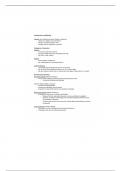Class notes
Psy1004F - Learning and conditioning Notes
- Course
- Intro to Psychology Part 1
- Institution
- University Of Cape Town (UCT)
Detailed and comprehensive Lectures notes on learning and conditioning. Covers all content received for the topic in this course. Essential!! To your success in academics!!
[Show more]



